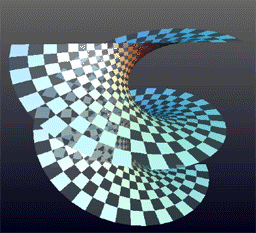Loading AI tools
Surface of revolution of a catenary From Wikipedia, the free encyclopedia
In geometry, a catenoid is a type of surface, arising by rotating a catenary curve about an axis (a surface of revolution).[1] It is a minimal surface, meaning that it occupies the least area when bounded by a closed space.[2] It was formally described in 1744 by the mathematician Leonhard Euler.


Soap film attached to twin circular rings will take the shape of a catenoid.[2] Because they are members of the same associate family of surfaces, a catenoid can be bent into a portion of a helicoid, and vice versa.
The catenoid was the first non-trivial minimal surface in 3-dimensional Euclidean space to be discovered apart from the plane. The catenoid is obtained by rotating a catenary about its directrix.[2] It was found and proved to be minimal by Leonhard Euler in 1744.[3][4]
Early work on the subject was published also by Jean Baptiste Meusnier.[5][4]: 11106 There are only two minimal surfaces of revolution (surfaces of revolution which are also minimal surfaces): the plane and the catenoid.[6]
The catenoid may be defined by the following parametric equations: where and and is a non-zero real constant.
In cylindrical coordinates: where is a real constant.
A physical model of a catenoid can be formed by dipping two circular rings into a soap solution and slowly drawing the circles apart.
The catenoid may be also defined approximately by the stretched grid method as a facet 3D model.

Because they are members of the same associate family of surfaces, one can bend a catenoid into a portion of a helicoid without stretching. In other words, one can make a (mostly) continuous and isometric deformation of a catenoid to a portion of the helicoid such that every member of the deformation family is minimal (having a mean curvature of zero). A parametrization of such a deformation is given by the system for , with deformation parameter , where:
Seamless Wikipedia browsing. On steroids.
Every time you click a link to Wikipedia, Wiktionary or Wikiquote in your browser's search results, it will show the modern Wikiwand interface.
Wikiwand extension is a five stars, simple, with minimum permission required to keep your browsing private, safe and transparent.